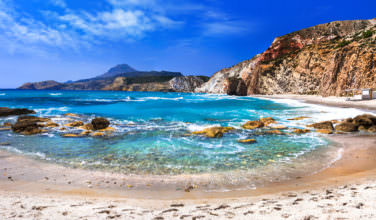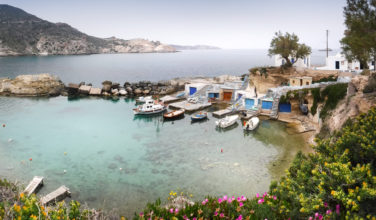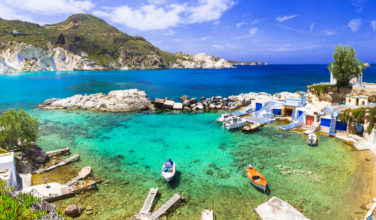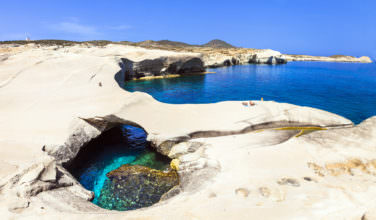Milos Island is a volcanic island in the Aegean Sea just north of the Sea of Crete. The volcanic background of the island has created a most impressive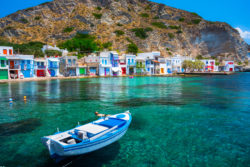 and unique landscape. The coastline varies in not only colors, but in geographical formations. This has produced natural resources such as perlite, kaolin, bentonite, pozzolan, and trachyte. The island of Milos also produces wine, cotton, and olives. These exports to the world are a great source of income to the island.
and unique landscape. The coastline varies in not only colors, but in geographical formations. This has produced natural resources such as perlite, kaolin, bentonite, pozzolan, and trachyte. The island of Milos also produces wine, cotton, and olives. These exports to the world are a great source of income to the island.
Northeast of the island is a mass of trachyte called Antimelos, Antimelos, or Erimomilos. Erimomilos means “desert Milos.” In antiquity, Antimelos was famous for its figs. It even contained a city. Antimelos was the subject of a dispute between the Milians and Kimolians and is now completely uninhabited.
As early as 15,000 years ago, the island was mined for obsidian. Obsidian is a volcanic rock that is glass-like. This natural glass was transported great distances and used to make sharp tools. Despite the mining of obsidian on the island, settlement weren’t developed. People would usually come to the island via boat, search for what they wanted, and leave again. It was during the Bronze Age, that the first settlement at Phylakopi was formed around the time that the extraction of obsidian was on the decline. These first settlers were tuna fishermen.
In 1896, excavations by the British School at Athens would uncover a town wall and Minoan-inspired structure, which was named the Pillar Room. The room has vivid wall paintings including a fresco of a flying fish, which has become famous. Unfortunately, part of the site has been washed away by the sea. Pottery was also excavated at the site. Then in 1970, a shrine was found at the site. The shrine contained Aegean figurines, including that of “Lady of Phylakopi.
Administrative Region of Milos Island, Greece
South Aegean
Population of Milos Island, Greece
4, 977
Top Attractions In Milos Island, Greece
Catacombs – Located in Tripiti. Found in 1844, they date back to the end of the 1st century. The catacombs were used as Christian cemeteries during Roman times.
Ancient Theatre – Located near the catacombs. Thought to have been built during Hellenistic times. Only the Roman portion remains today.
Church of Agia Triada – Located in Adamas, the port of Milos. Agia Triada means “Holy Trinity.” Church dates back to the 17th century.
Ecclesiastical Museum – A small museum in the Church of Agia Triada. Rare exhibits from Venetian time to present day. Features wood carvings, Byzantine icons, and golden votive offerings.
Firiplaka Beach – Located 15 km southeast of Plaka. Soft sand, pebbles, surrounded by huge rocks. A small, partly organized beach.
Sarakiniko Beach – 4 km east of Plaka. This is one of the most photographed beaches on Milos Island. The landscape is formed by volcanic rocks.
Agios Ioannis – Located on the west side of the island of Milos. A secluded beach that is nudist friendly. A non-organized beach.
Plaka Village – The capital of Milos Island. The Village was founded in 1800. The village spreads along the sides of a hill and provides a gorgeous view of the Gulf of Milos.
Church of Panagia Portiani – Located in Zefyria. Dates back to the 17th century and is a preserved monument. The church is dedicated to the Assumption of the Virgin.
Caves – There are many caves around Milos due to its volcanic geology. They can be explored via boat from the port. Truly unique landscape that shouldn’t be missed.


